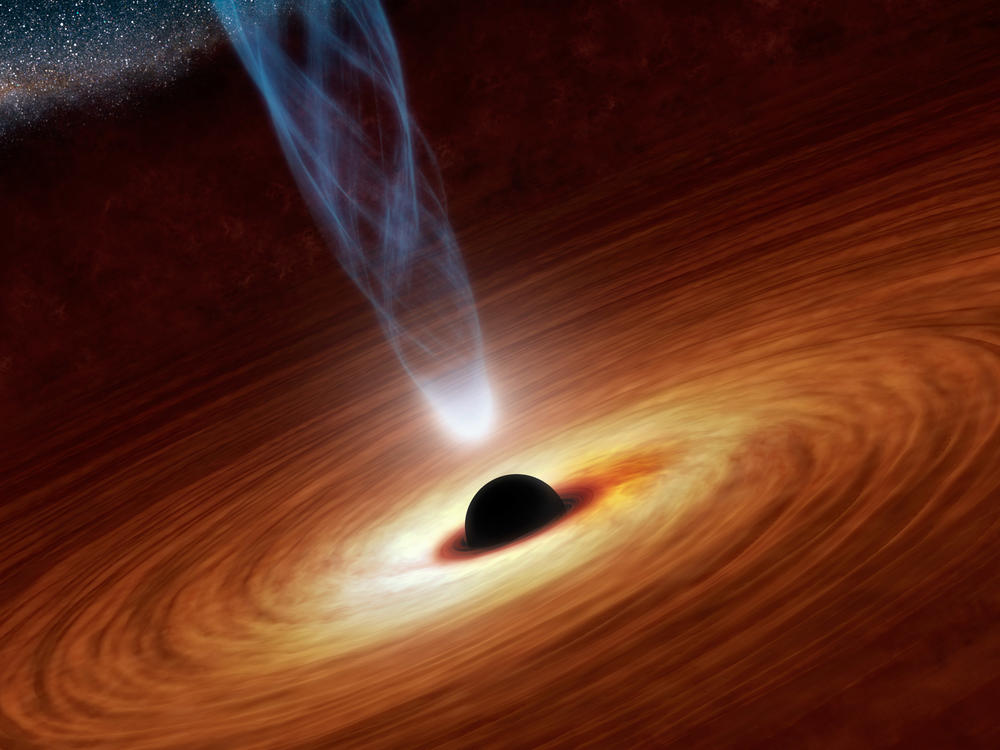Section Branding
Header Content
3 Scientists Awarded Nobel Prize In Physics For Discoveries Related To Black Holes
Primary Content
Perhaps fittingly for the year 2020, the Nobel Prize in physics has recognized research on black holes.
The prize was awarded to Roger Penrose of the University of Oxford, for demonstrating that the general theory of relativity leads to the formation of black holes; and to Reinhard Genzel of the Max Planck Institute for Extraterrestrial Physics and Andrea Ghez of the University of California, Los Angeles, for the discovery of a compact object at the center of the Milky Way galaxy that governs the orbits of stars, for which a black hole is the only known explanation.
Black holes are just what the name suggests — places where the gravitational pull is so great that nothing, not even light, can escape. Their existence was first suggested shortly after Albert Einstein unveiled his general theory of relativity in 1915. The theory postulates that the force of gravity is actually a warping of space-time caused by massive things like stars and planets. The theory suggested that there could exist an object so massive that it would cause space-time to collapse, trapping everything that came near it.
But for years after the prediction, researchers remained unsure whether black holes could form in the real universe, where conditions were often much more complicated than Einstein's rarefied equations. It was Penrose who found a more complex mathematical description of black hole formation that matched with the natural world. Published in 1965, his work "is still regarded as the most important contribution to the general theory of relativity since Einstein," according to the Nobel Prize committee, which awarded him half of the prize for his work.
Genzel and Ghez won the other half for painstaking observations of the supermassive black hole at the center of our own galaxy. Known as Sagittarius A*, it is more than 4 million times the mass of our sun. Sagittarius A* is shrouded behind a cloud of gas at the very core of the Milky Way, but undeterred, Genzel and Ghez used infrared telescopes to look through the gas. They painstakingly developed technologies to remove distortions caused by the gas and by Earth's own atmosphere to track objects orbiting very close to the black hole.
What they discovered was a tangled mass of stars in a great deal of trouble. The stars were tumbling chaotically around the Milky Way's center in a matter of years (by comparison, it takes Earth's sun about 230 million years to do a lap around the galaxy). Some were whizzing to within just a few light-hours of the black hole's event horizon — the point of no return. It was the clearest evidence yet that Sagittarius A* was indeed a black hole of unbelievable size and power. "There is no other explanation than a supermassive black hole," says Ulf Danielsson, a theoretical physicist at Uppsala University and a member of the Nobel Committee.
Reached by phone, prize winner Andrea Ghez said that black holes like Sagittarius A* remain mysterious. Modern theories of physics still cannot explain what happens when something falls beyond the point of no return. "That's part of the intrigue — we still don't know," Ghez said. "It pushes forward on our understanding of the physical world."
Ghez added that she hopes the prize will inspire young people, and particularly women, to pursue careers in science. "Science is so important, and pursuing the reality of our physical world is critical to us as human beings," she said. "Today, I feel more passionate about the teaching side of my job."
As is customary, the announcement was made at the Royal Swedish Academy of Sciences in Stockholm. The chemistry, literature and peace prizes will be awarded later this week, and the economics prize will be awarded Monday. The prize is worth 10 million Swedish krona ($1.12 million), with half awarded to Penrose and the remainder shared by Genzel and Ghez.
The Nobel Prizes will be awarded this year in a virtual ceremony because of the pandemic.
Copyright 2020 NPR. To see more, visit https://www.npr.org.

